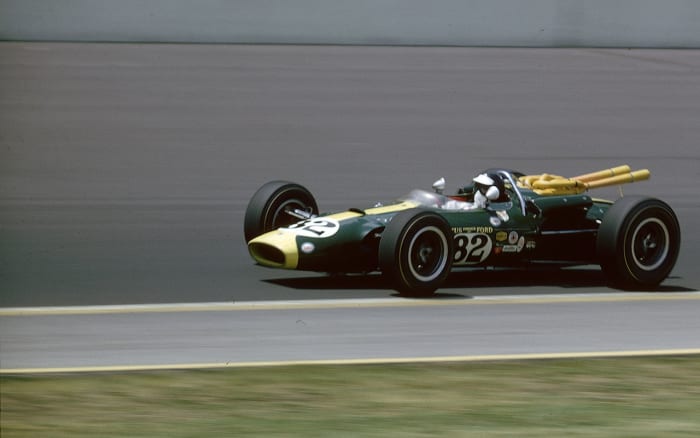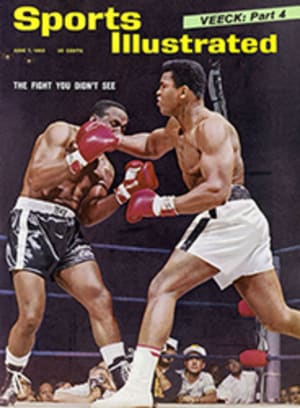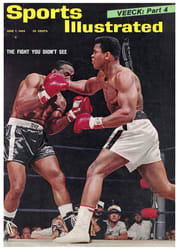Fiery 500 For A Cool Scot
Minute for minute there is no sporting event in the world as throat-catching as the Indianapolis 500-mile race. It is periodically dogged by disaster, as it was last year when two drivers were killed; yet in any year it has moments of racing greatness. Those who come to the Speedway hover each year in a fearful, three-and-a-half-hour limbo to see which will predominate. The 500 is an event that spectators are not certain they want to see—but it is so powerful they dare not look away. This was one of the good years, full of history and innocent of catastrophe. It was the year of the Lotus, the year of the rookies and it was the year the Scottish bagpipers came out to play.
Calm young Scotsman Jimmy Clark won the race ("Mmmmmm, no, there were no real tense moments out there") in what was really a double victory, because just finishing was in itself a triumph. Clark's run was an exercise in the sure use of power. He snaked his 500-hp Lotus-Ford along a corridor that became a salvage yard at an average speed of 150.686 miles an hour—the fastest 500 ever and one with a special magnificence as the first beyond the 150-mph barrier. And in winning he became one of the most affluent tourists temporarily employed in this country, earning something like a $200,000 share of the richest purse in Indy history.
The Ford Motor Company, which had first entered this classic three years ago on the theory that the 500 is a rolling test track for automotive innovation and a great spreader of glamour over all Ford cars, was also a notable winner. Ford proved that The Lively Ones—dual overhead-cam engines buttoned into 1,300-pound cars—would go like bullets on a two-and-a-half-mile track.
When Clark wheeled into the winner's circle (he picked up an extra $50 bonus there from a dairy association for accepting a quart of milk), 10 cars were left in the race behind him. Twenty-two cars were sitting like dismal Pop art displays in the garages of Gasoline Alley.
In the morning, amid balloons and bands, 33 cars had started in a frightening snarl of engines, their bodies polished to a racing gloss. But by Monday afternoon many of the favorites were in various stages of mechanical disarray. Parnelli Jones, engine sputtering, gas tank empty and steering gone haywire, captured second place by a miracle of timing; another lap and he would not have finished at all. A.J. Foyt was completely out of the race; the transmission on his car had burst in a futile chase after Clark. Dan Gurney was out of it with similar trouble.
The race was run on a hot, bright day, and the Speedway was packed to the picnic baskets—a record crowd of 305,000 was present. Outside Indiana—everybody inside the state must have been at the track—thousands more had assembled to watch the race on closed-circuit television. The first lap around the Brickyard—with Clark thrusting out ahead of the pole man, Foyt, from the No. 2 starting position—was clocked at 151.380 mph, a new track record. Almost immediately a Novi was out of the race, spurting oil. All day that was the way it was: records and cars fell with almost every lap.
The records belonged to Clark, who, with roguish zest, seemed to toy with Foyt. That is a dangerous game: the second time around an angry Foyt rolled up beside Clark high on the outside of the first turn, a place where veterans never go, and popped free on the back-stretch. Behind the two battling leaders came Gurney and Jones, with rookie Mario Andretti running coolly in fifth position. The rest of the field, already looking over their shoulders for Clark, were, figuratively and in most cases literally, out of it all. By 10 laps Clark's speed was up to 154.424 mph; he had not only snapped back past Foyt but had opened up a 20-yard lead on him.
Gurney and Jones were running wheel to wheel in another match of speed and mutual respect, and the 25-year-old Andretti was exciting an audience of his own. His Ford-powered car was the only balanced, symmetrical one at Indy, sitting squarely between its wheels. "Look," he had said, "it is ready to take out on a road course right now without changing a thing. She can turn right, too, you see? Not just turn left, like most Indy cars." Turning right and left like a motorized Red Grange, he drove the rest of the field wild with fancy broken-track running. By lap 43 he was an impertinent fourth and in position to devour any falterers ahead.
The rest of the race came in flashes—flashes of Clark whirring by the stands, his $150 per round in lap prizes ticking inexorably higher; flashes of racing brilliance; flashes of despair.
By lap 44, when Clark's lap winnings had rolled beyond $6,450, Gurney came coasting into the pits. So far so good. Perhaps he needed fuel. But, no, he climbed out of the car and looked into the stands with a half-smile. It was over; the car had stopped running. The car was sponsored by Yamaha, a Japanese manufacturer, and in Gurney's pit crew was the Ford Cobra man, Carroll Shelby, a road-racing type who goes where the action is. Shelby usually turns up at these events in casual attire topped by a monstrous, battered 10-gallon hat. On Monday he wore a judo-style jacket for luck. He should have stayed with the hat.
On Clark's 55th lap Jones was rolling along, with periodic puffs of smoke ringing from his car, and in the Jones pits crewmen began squatting down to peer under the car as it rolled past. A few pits down the line the second and last Novi was in for repairs, its laps numbered. On the 73rd lap, in a flurry of Foyt pulling in for a pit stop and Clark running free, it, too, expired. Andy Granatelli, chief of the annual Novi exercise in racing disaster, had a special message chalked on the pit board for the next loop around the course. It was not for the driver, it was for his wife, across the track in the main grandstand. "Dolly, chin up," it said.
With nearly half the race run Clark enjoyed a one-minute lead over Foyt; his average was 151.916 miles an hour, another track record. Part of it derived from an extraordinary 21-second pit stop, accomplished by Virginian Glen Wood and his crew. Wood is a stock-car builder and pit man, and he was specially recruited to cure Clark's previous pit troubles. (Clark required two stops—the second took only 25 seconds.)
Suddenly Clark's lead expanded from one minute to one year. Foyt coasted into the pits, engine shut off, his face set in a firm line. While thousands groaned, he eased out of the car, unbuckled his helmet and pulled off his golfing gloves. Before the race, plagued by accidents and a car that wouldn't handle properly, he had paced in front of his Gasoline Alley garage and groaned, "Oh, man, I'll be glad when this one is over. I'll be glad to get through this one." Now, he said it more simply. "Transmission's gone." With both Foyt and Gurney out of the action, there was no longer a ghost of a threat to the little Scot. On Clark's next whiz around the course his pit crew had the sign ready. "Foyt out," it said, and Clark nodded casually as he passed by.
Now there were 14 cars left. Anyone who could stay in the race could win fairly important money. "Use head," one thrifty crew signaled its driver. Five in the field were rookies, all smart enough not to push at this point. They all finished.
Racing's old line, the men prepared to battle most fiercely against insurgents like Clark, now had just one champion left: Parnelli. Their own cars were out and they drifted down the pit wall to stand in the Jones area. It looked like a convention of racing graybeards. Parnelli did not fail them—Parnelli never fails them—but he gave them a few moments of frenzy.
With five laps to go, Jones rolled along the grandstand straightaway, driving with one hand and pointing to his gas tank with the other. The meaning was clear: he was running low. Crewmen stood poised for him to roll into the pits, knowing grimly that if he did, it would cost second place. Next time around Jones gave them the back of his head. He was going to run for it—and his engine sounded like someone was crouched under the hood hammering to get out.
Clark made it, one gloved hand raised in triumph as he wheeled under the checkered flag. Jones made it, shaking his head grimly and steering the car in little, weaving pirouettes. On the back-stretch Jones's engine stopped. He was safely second. He also was bone dry. He pushed the car home. "We try harder than Avis," he dead-panned. Andretti made it, finishing a strong third after a marvelous trip.
It had been an exhausting day, with much breakage, but not a dangerous one for the men of Indy. At midrace, with the field scattered over a safe two-and-a-half-mile radius, the most reckless man around was the pilot of a tiny helicopter fluttering over the track, toting an enormous Plymouth promotional banner.
The fact that the starting lineup was shot through with exotic designs made it clear that a shake-out was coming. The Lotus-Fords, despite some signs of instability, clearly won a long lead in the design race. Rule-and-wrench men from Indy's old line such as A.J. Watson and Ted Halibrand needed more think time on their experimental chassis. So did the corps of new builders: of the genuine Brabham chassis from England; of the pretend Brabham, a made-in-America copy driven by Andretti; of the three Huffakers (none of which finished), cars whose suspension systems used water bellows instead of springs and handled like hot-water bottles on the corners; of the BRP's and Lolas from Blighty, these also nonfinishers except for one Lola.
Some grousing was inevitable. "I don't feel that these rear-engine cars are as safe as the old roadsters by any means," said Jones. "You have more moving parts in these new babies, more things that can break." Jones had called his last year's front-engine roadster "Calhoun," a term of close affection, and Jones was apt to talk of it in sentences that began, "Well, old Calhoun and me, we...." But he had angrily refused such a name for this year's Lotus. "I may call it 'Trouble,' " he growled.
But as Parnelli and the others knew, grousing would get them nowhere. The old Indy order was shoved aside Monday by a road-racing driver from Scotland; by that Limey builder of the Lotuses, Colin Chapman—the man with the David Niven profile; by a giant company with a hot new engine; and, adding insult to grievous injury, by that crew of southern rebels, interlopers from stock-car racing, who functioned so superbly in Clark's swift and precise pit.
PHOTO
JAMES DRAKE AND TONY
TRIOLO
Swooping into the lead as the 500 begins, Clark races ahead of pole man A.J. Foyt (car No. 1), Dan Gurney (17) and Parnelli Jones (98).
TWO PHOTOS
JAMES DRAKE AND TONY
TRIOLO
Clark exults in Victory Lane (above) after record-breaking drive which also added a new dimension to the fame of England's Colin Chapman (below), builder of the winning Lotus car.


